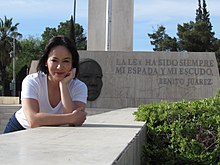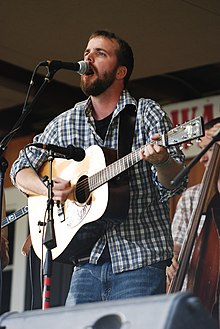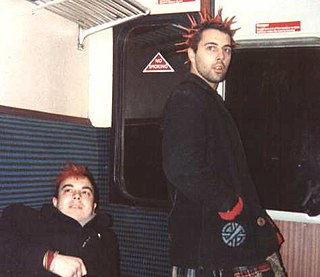
Punk fashion is the clothing, hairstyles, cosmetics, jewellery, and body modifications of the punk counterculture. Punk fashion varies widely, ranging from Vivienne Westwood designs to styles modeled on bands like The Exploited to the dressed-down look of North American hardcore. The distinct social dress of other subcultures and art movements, including glam rock, skinheads, greasers, and mods have influenced punk fashion. Punk fashion has likewise influenced the styles of these groups, as well as those of popular culture. Many punks use clothing as a way of making a statement.
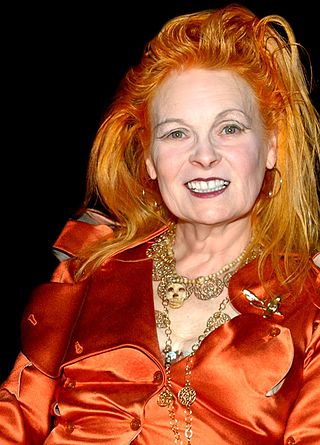
Dame Vivienne Isabel Westwood was an English fashion designer and businesswoman, largely responsible for bringing modern punk and new wave fashions into the mainstream. In 2022, Sky Arts ranked her the 4th most influential artist in Britain of the last 50 years.
Sex was a boutique run by Vivienne Westwood and her then-partner Malcolm McLaren at 430 King's Road, London between 1974 and 1976. It specialised in clothing that defined the look of the punk movement.

Rei Kawakubo is a Japanese fashion designer based in Tokyo and Paris. She is the founder of Comme des Garçons and Dover Street Market. In recognition of the notable design contributions of Kawakubo, an exhibition of her designs entitled Rei Kawakubo/Comme des Garçons, Art of the In-Between opened on 5 May 2017 at the Metropolitan Museum of Art in Manhattan, modeled by Rihanna.

Fashion in the 1990s was defined by a return to minimalist fashion, in contrast to the more elaborate and flashy trends of the 1980s. One notable shift was the mainstream adoption of tattoos, body piercings aside from ear piercing and, to a much lesser extent, other forms of body modification such as branding.
Japanese street fashion refers to a number of styles of contemporary modern clothing in Japan. Created from a mix of both local and foreign fashion brands, Japanese street fashions tend to have their own distinctive style, with some considered to be extreme and imaginative, with similarities to the haute couture styles seen on European catwalks.

Fashion of the 1980s was characterized by a rejection of 1970s fashion. Punk fashion began as a reaction against both the hippie movement of the past decades and the materialist values of the current decade. The first half of the decade was relatively tame in comparison to the second half, which was when apparel became very bright and vivid in appearance.

The fashion of the 2000s is often described as a global mash up, where trends saw the fusion of vintage styles, global and ethnic clothing, as well as the fashions of numerous music-based subcultures. Hip-hop fashion generally was the most popular among young people of both sexes, followed by the retro-inspired indie look later in the decade.

Fashion in the 1970s was about individuality. In the early 1970s, Vogue proclaimed "There are no rules in the fashion game now" due to overproduction flooding the market with cheap synthetic clothing. Common items included mini skirts, bell-bottoms popularized by hippies, vintage clothing from the 1950s and earlier, and the androgynous glam rock and disco styles that introduced platform shoes, bright colors, glitter, and satin.

History of fashion design refers specifically to the development of the purpose and intention behind garments, shoes, accessories, and their design and construction. The modern industry, based around firms or fashion houses run by individual designers, started in the 19th century with Charles Frederick Worth who, beginning in 1858, was the first designer to have his label sewn into the garments he created.

Fashion design is the art of applying design, aesthetics, clothing construction and natural beauty to clothing and its accessories. It is influenced by culture and different trends and has varied over time and place. "A fashion designer creates clothing, including dresses, suits, pants, and skirts, and accessories like shoes and handbags, for consumers. He or she can specialize in clothing, accessory, or jewelry design, or may work in more than one of these areas."

Grunge fashion refers to the clothing, accessories and hairstyles of the grunge music genre. This subculture emerged in mid-1980s Seattle, and had reached wide popularity by the mid 1990s. Grunge fashion is characterized by durable and timeless thrift-store clothing, often worn in a loose, androgynous manner to de-emphasize the silhouette. The style was popularized by music bands Nirvana, Soundgarden and Pearl Jam.

Street style is fashion that is considered to have emerged not from studios, but from the population at large. Street fashion is generally associated with youth culture, and is most often seen in major urban centers. Magazines and newspapers commonly feature candid photographs of individuals wearing urban, stylish clothing. Mainstream fashion often appropriates street fashion trends as influences. Most major youth subcultures have had an associated street fashion. Street style is different all around the globe.
Joe Saba is an Australian fashion designer and fashion business owner of Lebanese descent.

The 2010s were defined by hipster fashion, athleisure, a revival of austerity-era period pieces and alternative fashions, swag-inspired outfits, 1980s-style neon streetwear, and unisex 1990s-style elements influenced by grunge and skater fashions. The later years of the decade witnessed the growing importance in the western world of social media influencers paid to promote fast fashion brands on Pinterest and Instagram.
Oversized fashion, distinct from plus-sized fashion, consists of clothing and other accessories that are larger than normal and reflect some sort of attitude, message, or trend of the period at hand. While oversized fashion trends from the 1920s to the turn of the century vary from decade to decade, there are many overarching themes that have been expressed during the past one hundred or so years. Masculinity, for example, has played a large role in many of the underlying communications of the fashions, although virility is manifested differently in the clothing depending on the era. Oversized fashion production, furthermore, runs largely parallel with the states of the American and global economies. Modernly, oversized fashion has taken on a new form - primarily in the realm of oversized accessories.

The clothing style and fashion sense of the Philippines in the modern-day era have been influenced by the indigenous peoples, Chinese waves of immigration, the Spaniards, and the Americans, as evidenced by the chronology of events that occurred in Philippine history. At present, Filipinos conform their way of dressing based on classic fashion or prevailing fashion trends.
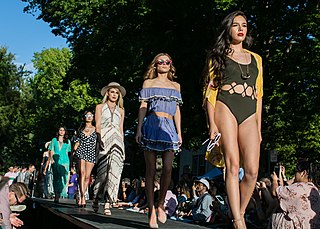
The trickle-up effect in the fashion field, also known as bubble-up pattern, is an innovative fashion theory first described by Paul Blumberg in the 1970s. This effect describes when new trends are found on the streets, showing how innovation flows from the lower class to upper class. It is in contrast with classical theories of fashion consumption, such as those of Georg Simmel and Thorstein Veblen, who theorize that the upper classes are the ones who dictate the fashion flow.
Deconstruction is a fashion phenomenon of the 1980s and 1990s. It involves the use of costume forms that are based on identifying the structure of clothing - they are used as an external element of the costume. This phenomenon is associated with designers Martin Margiela, Yohji Yamamoto, Rei Kawakubo, Karl Lagerfeld, Ann Demeulemeester and Dries van Noten. Deconstructivism in fashion is considered as part of a philosophical system formed under the influence of the works of Jacques Derrida.

Music and fashion have long been closely linked. Artistic movements in music have often been associated with distinct fashions. Both industries have also had considerable influence on each other. Many famous musicians have also had notable styles and influenced fashion.

